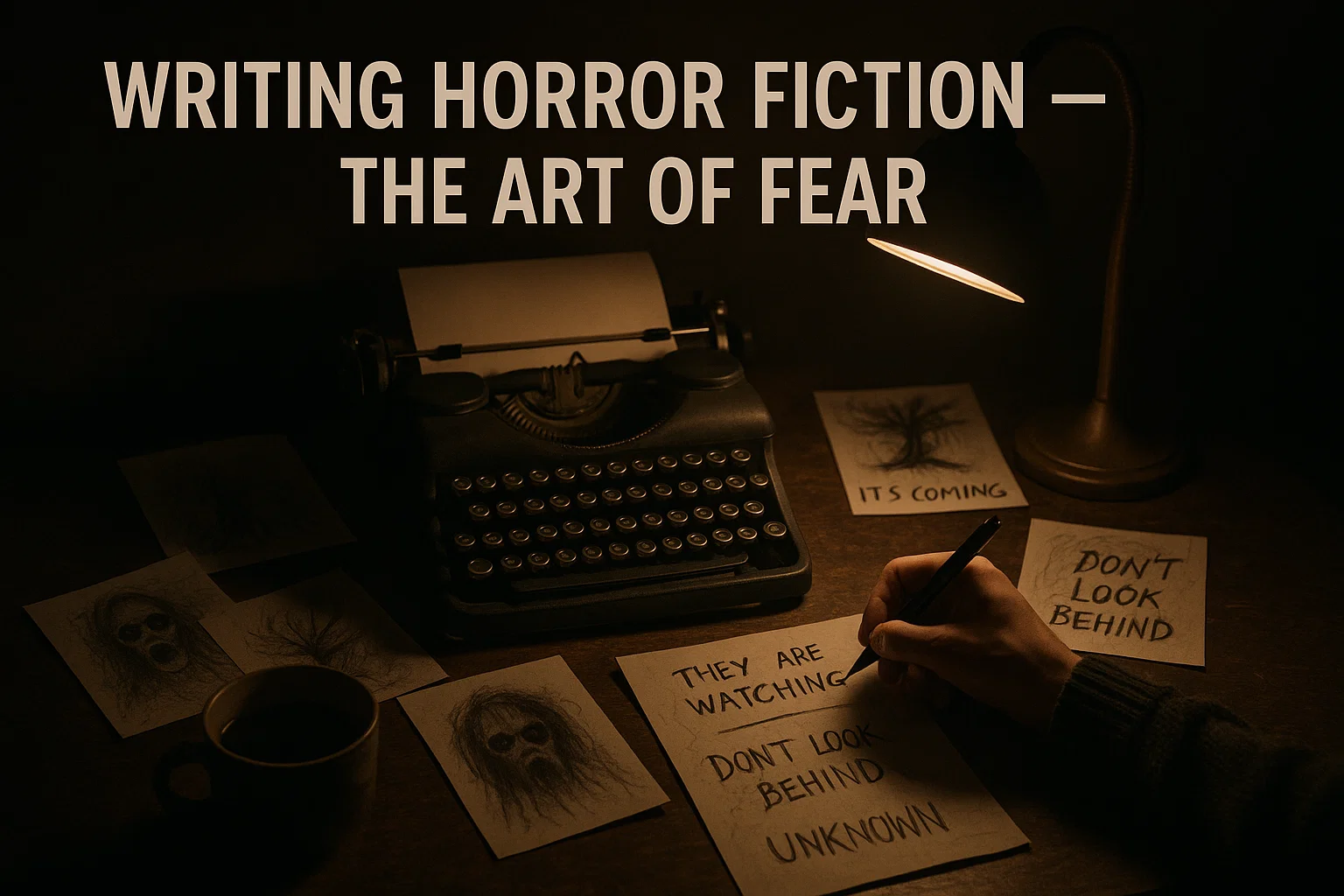So, how do you write horror that really terrifies, not just startles? Let’s break it down.
Understanding Why Horror Is So Tricky
Is horror hard to write? Oh, absolutely. But it’s also addictive.
You’re not just telling a story you’re manipulating emotions. Horror is about building trust, then betraying it. You invite the reader into a familiar space, then twist it until they start questioning everything. That balance between comfort and chaos is what makes it tricky.
Unlike romance or adventure, horror has no safety net. A misplaced detail, a cliché jump scare, or too much explanation, and the tension evaporates. But when you get it right, it’s electric. Readers remember your story long after they close the page because you made them feel something primal.
Step One: Scare Yourself First
Every horror writer, from Shirley Jackson to Stephen King, agrees on one golden rule: If it doesn’t scare you, it won’t scare anyone else.
Ask yourself what genuinely unsettles you? Is it losing control? The dark? The idea of something standing just behind you? Start from there.
Your own fears are unique. They’re specific, personal, and real. That’s the kind of authenticity horror thrives on. Because fear, like laughter, is contagious if you feel it while writing, readers will too.
Step Two: Start With the Violation
Every good horror story breaks a rule something sacred or safe gets violated. It could be a physical rule (like gravity going wrong), a moral one (innocence corrupted), or even psychological (trust turning into paranoia).
The question you need to ask is simple: What shouldn’t happen and what if it did?
That single question can build an entire story.
Think about The Ring technology (a VHS tape) becomes a curse. Or The Haunting of Hill House, where a family home turns against its owners. That violation of safety, sanity, or nature becomes the heartbeat of horror.
Step Three: Create Characters Who Feel Real
Here’s the truth: if your readers don’t care about the characters, they won’t care about the scares.
Forget the stereotype of the “dumb horror victim.” Your protagonists should be relatable, flawed, and emotionally grounded. When something terrible happens, the reader needs to think, That could’ve been me.
Give them motivations. Fears. Backstories. Maybe your main character is terrified of being alone so of course the plot isolates them. Maybe they don’t believe in ghosts until they have to.
The point is: horror only works when there’s something at stake.
Step Four: Build the Atmosphere
Creepy writing isn’t about describing everything in detail it’s about suggestion. A creak in the hallway. The way shadows bend wrong. The faint smell of iron that won’t go away.
Use the five senses to pull readers into the world. Don’t just tell them it’s dark make them feel the dark pressing in.
A few tricks:
- Use shorter sentences when tension rises. It creates a heartbeat rhythm.
- Focus on small, relatable sensations like the sting of cold air or the tremor of silence.
- Avoid overexplaining your monster or ghost. Fear of the unknown is your greatest weapon.
The best horror writers know when to shut up. What you don’t say is sometimes more terrifying than what you do.
Step Five: Master Pacing and Tension
Think of horror like a rollercoaster you can’t be at the peak the whole time. You need climbs, dips, and moments of deceptive calm.
Alternate between build-up and release. Let readers breathe, then hit them again. This rhythm keeps them hooked.
Here’s a trick: end scenes on uneasy notes. Don’t tidy up. Let something feel “off.” That unresolved dread forces readers to keep going.
And remember tension isn’t always about action. A quiet dinner where no one speaks can be scarier than a chase through the woods.
Step Six: How To Do Creepy Writing
Creepy writing is an art of restraint. You don’t go for the scream you go for the shiver.
Here’s how:
- Layer the details slowly. Start with something small a misplaced object, a strange whisper, a flicker in the light. Build up the unease one brick at a time.
- Use human reactions. Describe the pulse quickening, the sweat, the confusion. Readers mirror what the character feels.
- Keep some mystery alive. Don’t show the monster too soon. The imagination does far scarier things.
- Subvert expectations. Let comfort turn hostile a lullaby becomes disturbing, a smile hides malice.
- End with uncertainty. Even after the resolution, leave a thread of doubt. Maybe the horror isn’t gone. Maybe it’s waiting.
That lingering discomfort is what makes your story memorable.
Step Seven: The Perfect Opening
Your first line should grab attention not gently, but like a cold hand on the back of the neck.
Start with action, unease, or contradiction. Something that makes readers pause. For instance:
“The first time I died, it was an accident.”
See? You’d read the next line, wouldn’t you?
Avoid long introductions or world-building dumps. Drop the reader into the tension and let them find their footing as they go.
Step Eight: Revising With Fear in Mind
Revision is where the horror sharpens.
- Cut the fluff. Every sentence should move tension forward.
- Reread scenes aloud do they sound eerie?
- Ask beta readers where they felt most uncomfortable. That’s your emotional sweet spot.
- Remove anything that explains too much. Horror thrives in the grey areas.
If you want a trick: print your story, read it at night, alone. If it still scares you you’ve nailed it.
How Much Do Horror Writers Get Paid?
Let’s be honest horror writing isn’t always a gold mine, but it can pay off if you build a name.
- Short stories in magazines or anthologies can pay from 5 to 10 cents per word.
- Novels often come with small advances, but royalties add up over time.
- Some professional horror writers earn between £40,000 and £80,000 a year, though most make far less starting out.
- Self-publishing on platforms can also be lucrative if you find your audience.
The best part? The horror community is passionate. Fans remember names. If they love your work once, they’ll follow you forever.
Who’s the Youngest Horror Author?
Fun fact: some kids are already making waves. Natalia Rose Wolfman was called “the world’s youngest horror author” when she published The Woods while still in primary school. Others have followed suit, proving fear has no age limit.
So if you’ve ever thought you’re too young or too old to write horror, think again. Fear doesn’t discriminate.
Quick Horror Writing Checklist
| Element | What To Check |
|---|---|
| Fear Source | Does it target a primal fear death, isolation, madness, loss? |
| Character Depth | Do we care about them? |
| Atmosphere | Is the setting alive with tension and sensory detail? |
| Pacing | Are there rises and drops in tension? |
| Mystery | Are you leaving enough unsaid? |
| Ending | Does it linger in the reader’s mind? |
Keep this beside you as you write it’s your flashlight in the dark.
The Mindset of a Horror Writer
Here’s a secret: good horror writers aren’t pessimists. They’re observers.
They watch what makes people tick. They understand that fear is one of the most honest emotions we have. That’s why horror stories, when written well, aren’t just about monsters they’re about us.
What happens when we’re pushed to the edge? When love, faith, or sanity begin to crack? That’s the question every horror story answers in its own way.
So don’t chase trends or formulas. Chase what unsettles you. Make it personal. Make it human.
And when you need a break from your own writing chaos, check out tools like Spinbot an AI reword tool that can help you rephrase sections, rewrite sentences, and keep your creative energy focused on the scary stuff, not the grammar ghosts.
Final Thoughts
Writing horror fiction isn’t just about frightening your readers it’s about making them feel something real. Fear, empathy, curiosity, awe. Horror is the most emotional genre out there, and that’s what makes it so powerful.
You don’t have to invent the next Stephen King monster. You just have to make your reader look at the dark and think, “What if?”
That’s the true heartbeat of horror.

Rachel combines her technical expertise with a flair for clear, accessible writing. A graduate of the University of Edinburgh, she specializes in creating detailed tech-focused content, Govt Jobs, Payslips that educates our readers about the latest in web development and SEO tools at Spinbot blog.
